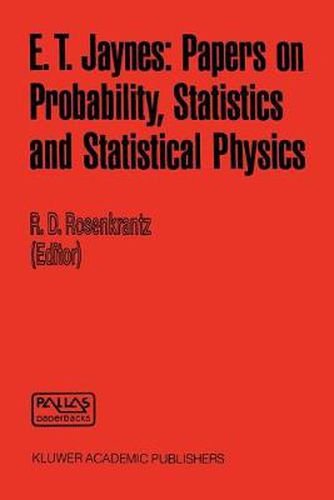Readings Newsletter
Become a Readings Member to make your shopping experience even easier.
Sign in or sign up for free!
You’re not far away from qualifying for FREE standard shipping within Australia
You’ve qualified for FREE standard shipping within Australia
The cart is loading…






This title is printed to order. This book may have been self-published. If so, we cannot guarantee the quality of the content. In the main most books will have gone through the editing process however some may not. We therefore suggest that you be aware of this before ordering this book. If in doubt check either the author or publisher’s details as we are unable to accept any returns unless they are faulty. Please contact us if you have any questions.
The first six chapters of this volume present the author’s ‘predictive’ or information theoretic’ approach to statistical mechanics, in which the basic probability distributions over microstates are obtained as distributions of maximum entropy (Le. , as distributions that are most non-committal with regard to missing information among all those satisfying the macroscopically given constraints). There is then no need to make additional assumptions of ergodicity or metric transitivity; the theory proceeds entirely by inference from macroscopic measurements and the underlying dynamical assumptions. Moreover, the method of maximizing the entropy is completely general and applies, in particular, to irreversible processes as well as to reversible ones. The next three chapters provide a broader framework - at once Bayesian and objective - for maximum entropy inference. The basic principles of inference, including the usual axioms of probability, are seen to rest on nothing more than requirements of consistency, above all, the requirement that in two problems where we have the same information we must assign the same probabilities. Thus, statistical mechanics is viewed as a branch of a general theory of inference, and the latter as an extension of the ordinary logic of consistency. Those who are familiar with the literature of statistics and statistical mechanics will recognize in both of these steps a genuine ‘scientific revolution’ - a complete reversal of earlier conceptions - and one of no small significance.
$9.00 standard shipping within Australia
FREE standard shipping within Australia for orders over $100.00
Express & International shipping calculated at checkout
This title is printed to order. This book may have been self-published. If so, we cannot guarantee the quality of the content. In the main most books will have gone through the editing process however some may not. We therefore suggest that you be aware of this before ordering this book. If in doubt check either the author or publisher’s details as we are unable to accept any returns unless they are faulty. Please contact us if you have any questions.
The first six chapters of this volume present the author’s ‘predictive’ or information theoretic’ approach to statistical mechanics, in which the basic probability distributions over microstates are obtained as distributions of maximum entropy (Le. , as distributions that are most non-committal with regard to missing information among all those satisfying the macroscopically given constraints). There is then no need to make additional assumptions of ergodicity or metric transitivity; the theory proceeds entirely by inference from macroscopic measurements and the underlying dynamical assumptions. Moreover, the method of maximizing the entropy is completely general and applies, in particular, to irreversible processes as well as to reversible ones. The next three chapters provide a broader framework - at once Bayesian and objective - for maximum entropy inference. The basic principles of inference, including the usual axioms of probability, are seen to rest on nothing more than requirements of consistency, above all, the requirement that in two problems where we have the same information we must assign the same probabilities. Thus, statistical mechanics is viewed as a branch of a general theory of inference, and the latter as an extension of the ordinary logic of consistency. Those who are familiar with the literature of statistics and statistical mechanics will recognize in both of these steps a genuine ‘scientific revolution’ - a complete reversal of earlier conceptions - and one of no small significance.